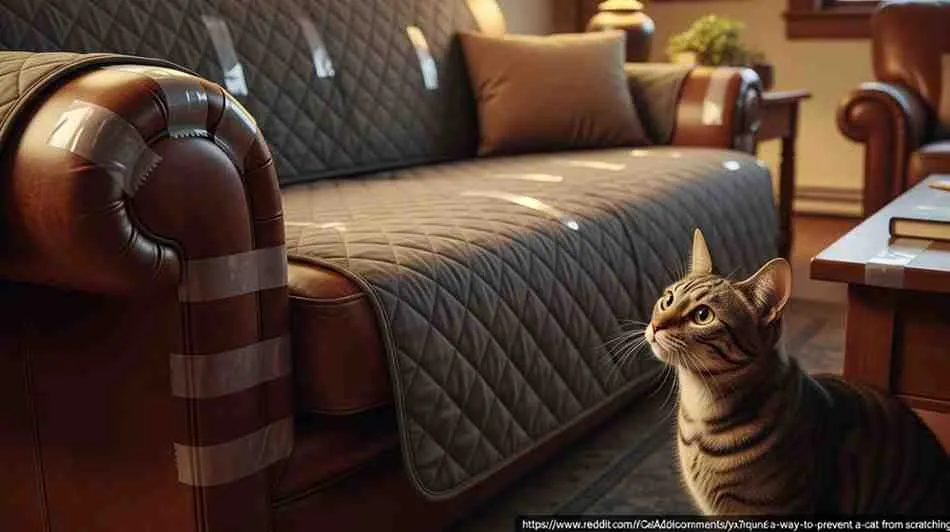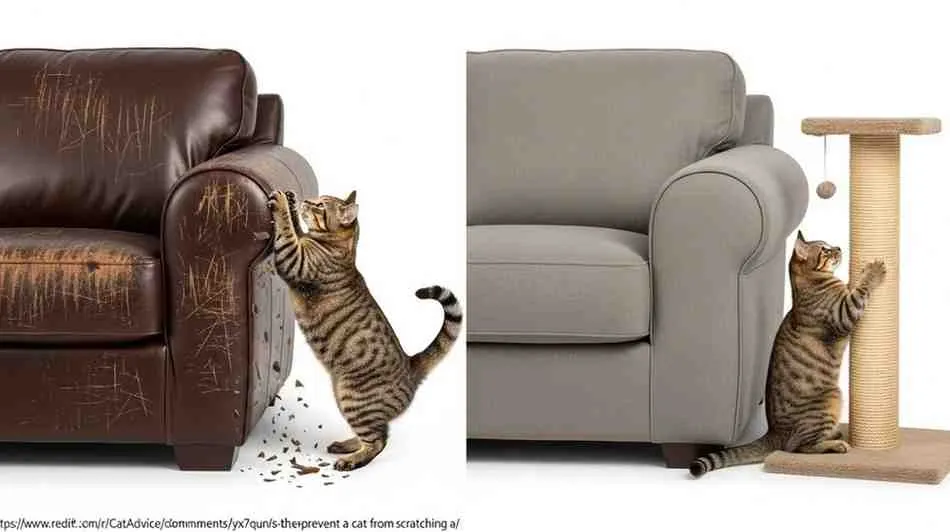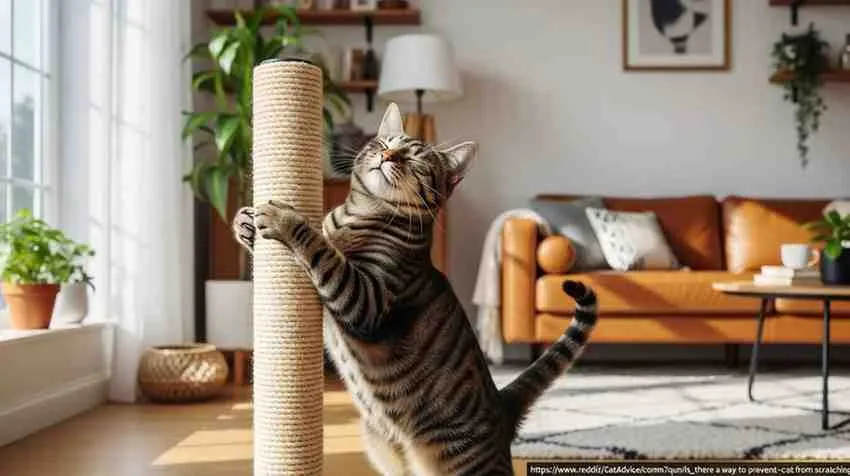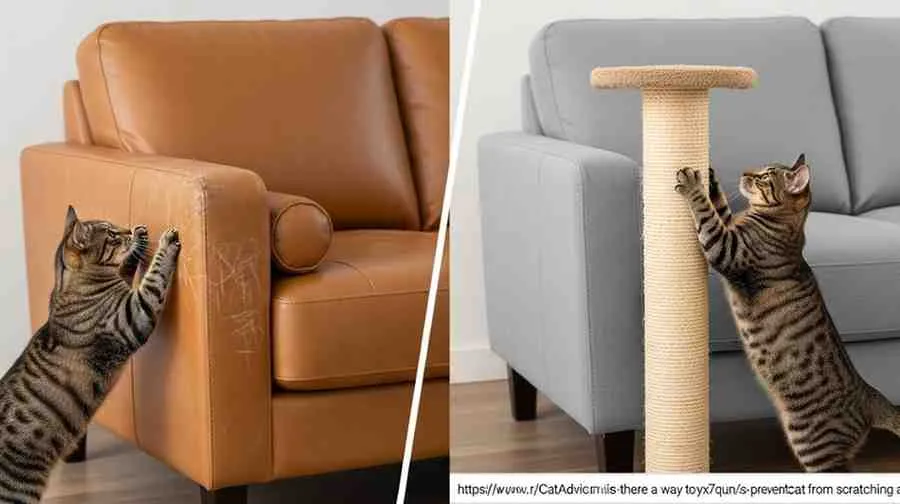INTRODUCTION
If you’re a cat owner with a beautiful leather sofa, you’ve probably experienced that heart-sinking moment when you discover fresh scratch marks across your expensive furniture You thought how to protect your leather sofa from cats. You’re not alone—thousands of cat owners struggle with this exact problem every day. The good news? You can protect your leather sofa from cats without resorting to drastic measures like declawing or getting rid of your beloved pet.
In this comprehensive guide, you’ll discover proven strategies to stop cat scratching furniture, learn why cats scratch in the first place , how to protect leather sofa from cats and find practical solutions that work for both you and your feline friend. Whether you’re dealing with a kitten that’s just discovered the joy of scratching or an adult cat with established habits, these techniques will help you preserve your leather furniture while keeping your cat happy and healthy.
Why Do Cats Scratch Leather Sofas? Understanding Feline Behavior
Before we dive into solutions, it’s essential to understand why cats scratch couches in the first place. Scratching isn’t just destructive behavior—it’s a natural, instinctive activity that serves multiple important purposes for your cat.
Natural Instincts and Biological Needs
Cats scratch for several fundamental reasons that are hardwired into their DNA. First and foremost, scratching helps them maintain their claws. The scratching motion removes the dead outer layer of their claws, revealing sharp, healthy claws underneath. This process is similar to how we might trim our fingernails, except cats do it naturally through scratching.
Territory marking is another crucial reason cats scratch. Cats have scent glands in their paw pads, and when they scratch, they leave both a visual mark and their scent on the surface. This communicates to other cats (and reassures themselves) that this is their territory. Your leather sofa, unfortunately, makes an excellent canvas for this territorial display.

Cats also scratch to stretch their bodies, particularly their back, shoulder, and leg muscles. After a nap, you’ll often see cats head straight for a scratching surface to get a full-body stretch. The resistance provided by your sofa’s leather surface makes it perfect for this purpose.
Finally, scratching serves as an emotional outlet. Cats scratch when they’re excited, stressed, or simply need to release pent-up energy. If your cat is feeling anxious or overstimulated, your leather sofa might bear the brunt of those feelings.
Why Leather Sofas Are Particularly Attractive to Cats
Leather presents a unique challenge because it offers several qualities that cats find irresistible. The texture of leather provides excellent resistance for claw sharpening—not too soft, not too hard. The surface also produces satisfying sounds when scratched, which can be rewarding for cats.
Additionally, leather sofas are often positioned in prime locations within your home—areas where your cat spends time, where family gathers, and where your scent is strongest. This makes them natural targets for territorial marking. The visibility of scratch marks on leather also means cats can clearly see the results of their scratching, which reinforces the behavior.
Effective Methods to Stop Cat Scratching Furniture
Now that you understand the “why” behind the behavior, let’s explore practical solutions for how to protect your leather sofa from cats. The most effective approach typically combines multiple strategies rather than relying on a single method.
1. Provide Irresistible Scratching Alternatives
The foundation of protecting your leather sofa is giving your cat better options. Simply telling a cat “no” without offering an alternative is like asking someone to stop eating without providing food—it’s not going to work long-term.
Choosing the Right Scratching Post
Not all scratching posts are created equal, and many cat owners make the mistake of buying posts that don’t appeal to their cats. Here’s what makes an effective scratching post:
- Height matters: The post should be tall enough for your cat to fully stretch while scratching. Most cats need posts at least 30-32 inches tall. If your cat is large or particularly enjoys stretching, consider posts up to 36 inches.
- Stability is crucial: A wobbly post is worse than no post at all. Cats need to feel confident that the post won’t tip over when they put their full weight into scratching. Look for posts with heavy, wide bases or consider wall-mounted options.
- Texture preferences: Most cats prefer sisal rope or sisal fabric because it provides excellent resistance and feels satisfying under their claws. However, some cats prefer carpet, corrugated cardboard, or even bare wood. You may need to experiment to find what your cat likes best.
- Vertical and horizontal options: While many cats prefer vertical scratching surfaces (which is why your sofa’s arms are vulnerable), some cats enjoy horizontal scratching. Provide both options to cover all preferences.
Strategic Placement of Scratching Posts
Where you place scratching posts is just as important as the posts themselves. Follow these placement strategies:
- Near the sofa: Place at least one scratching post within a few feet of your leather sofa. This makes it easy for your cat to choose the appropriate surface when the urge strikes.
- In high-traffic areas: Position posts where your cat naturally spends time—near windows, next to their favorite napping spots, and in rooms where the family gathers.
- By sleeping areas: Cats often scratch immediately after waking up, so having a post near their bed or favorite sleeping spot increases usage.
- Multiple locations: If you have a multi-level home or multiple rooms, provide several scratching options throughout your space. The general rule is one post per cat, plus one extra, distributed throughout your home.
2. Make Your Leather Sofa Less Appealing
While providing alternatives, you should simultaneously make your leather sofa less attractive for scratching. This two-pronged approach accelerates behavior change.
Physical Barriers and Deterrents
Several physical deterrents can effectively protect your leather furniture:
Furniture covers and throws: High-quality, thick throws or furniture covers create a barrier between your cat’s claws and your leather. Look for covers made from tightly woven fabrics that are difficult to scratch. Some covers are specifically designed with anti-scratch materials. While this doesn’t solve the scratching behavior, it protects your sofa while you work on training.
Double-sided tape: Cats dislike the sticky feeling on their paws, making double-sided tape an effective short-term deterrent. Products like Sticky Paws are specifically designed for furniture and won’t damage leather when removed. Apply strips to the areas your cat typically scratches. Most cats will try once or twice, dislike the sensation, and seek out other surfaces.
Plastic or acrylic guards: Clear plastic guards can be attached to sofa arms and corners—the areas cats most frequently target. These smooth surfaces don’t provide the satisfying resistance cats seek, encouraging them to use their scratching posts instead. While not the most aesthetically pleasing option, they’re temporary and highly effective.
Aluminum foil: Many cats dislike the texture and sound of aluminum foil. Covering scratched areas with foil can deter scratching while you train your cat to use appropriate surfaces. Like tape, this is a temporary solution.
Scent-Based Deterrents
Cats have sensitive noses, and certain scents can discourage them from specific areas:
Citrus scents: Most cats dislike citrus fragrances. Spraying diluted lemon or orange essential oils (mixed with water) on your sofa can deter scratching. However, test a small area first to ensure it doesn’t stain your leather, and never use undiluted essential oils as these can be harmful to cats.
Commercial cat deterrent sprays: Products designed specifically to deter cats from furniture are available at pet stores. These typically use scents that humans find neutral or pleasant but cats find off-putting. Look for products that are safe for leather and non-toxic to cats.
Catnip on scratching posts: While not technically a deterrent for the sofa, rubbing catnip on your cat’s scratching posts makes them more attractive, indirectly reducing interest in your furniture.
3. Training and Behavior Modification Techniques
Successful protection of your leather sofa requires actively training your cat to use appropriate scratching surfaces. This process takes patience and consistency but yields lasting results.
Positive Reinforcement Training
The most effective training method involves rewarding desired behaviors rather than punishing unwanted ones:
Catch them doing it right: Whenever you see your cat using their scratching post, immediately praise them enthusiastically and offer a treat. This positive association strengthens the behavior you want to encourage.
Redirection technique: When you catch your cat scratching the sofa, calmly interrupt them (a simple “ah-ah” or clap works), then immediately redirect them to their scratching post. Once they scratch the post, even briefly, reward them lavishly with treats and praise. This teaches them that scratching posts, not sofas, earn rewards.
Play sessions near scratching posts: Engage your cat in play sessions near their scratching posts. When cats are excited during play, they often scratch. Having the post nearby during these high-energy moments creates positive associations and natural opportunities to use it.
Consistency is key: Everyone in your household must follow the same training approach. Mixed messages confuse cats and slow progress. Make sure all family members know to redirect scratching behavior and reward appropriate scratching.
What Not to Do
Avoid punishment-based approaches, which are ineffective and can damage your relationship with your cat:
- Don’t yell or physically punish: This creates fear and stress without teaching appropriate behavior. Stressed cats often scratch more, not less.
- Avoid spray bottles: While popular, spraying cats with water can create fear-based associations and doesn’t teach them where they should scratch.
- Never declaw: Declawing is actually an amputation of the last bone in each toe. It’s painful, can lead to long-term complications, and is banned in many countries and U.S. cities. It’s never an appropriate solution for furniture scratching.
4. Environmental Enrichment and Exercise
Many scratching problems stem from boredom, pent-up energy, or stress. Addressing these underlying issues can significantly reduce furniture scratching.
Daily Play and Exercise
Cats need physical and mental stimulation. Schedule at least two 15-20 minute play sessions daily using interactive toys like wand toys, laser pointers (always ending with a physical toy they can “catch”), or puzzle feeders. A tired, satisfied cat is much less likely to scratch your furniture out of boredom or excess energy.
Vertical Space and Climbing Opportunities
Cats are natural climbers and feel secure when they can observe from high vantage points. Cat trees, wall-mounted shelves, and window perches provide exercise and entertainment while reducing stress. Many cat trees include built-in scratching posts, addressing multiple needs simultaneously.
Mental Stimulation
Puzzle feeders, toys and even simple cardboard boxes provide mental enrichment that keeps cats engaged. Rotating toys every few days maintains novelty and interest, reducing the likelihood that your cat will turn to your sofa for entertainment.
5. Nail Maintenance and Soft Paws
Regular nail maintenance reduces the damage cats can inflict on leather furniture:
Regular Nail Trimming
Trimming your cat’s nails every 2-3 weeks significantly reduces scratching damage. If you’re uncomfortable doing this yourself, groomers and veterinary clinics offer nail trimming services. Trimmed nails still allow natural scratching behavior but with less destructive results.
Soft Paws (Nail Caps)
Soft Paws or similar vinyl nail caps can be applied over your cat’s claws. These small, soft covers prevent claw damage to furniture while still allowing natural scratching motions. Each application lasts 4-6 weeks before needing replacement. Many cat owners find this an excellent temporary solution while training is in progress.

Real-Life Success Stories: Cat Owners Who Protected Their Leather Sofas
Understanding what works in theory is helpful, but real-world examples show these methods in action.
Sarah’s Story: From Destruction to Harmony
Sarah invested in a beautiful leather sectional only to discover her two-year-old cat, Luna, treating it like a personal scratch pad. “I was devastated,” Sarah recalls. “Within a week, the arms were completely shredded.”
Sarah’s solution combined multiple approaches. She placed two tall sisal scratching posts on either side of her sectional and applied double-sided tape to the damaged areas. Every time Luna approached the sofa, Sarah redirected her to a post and immediately rewarded her with treats when she used it.
“Within three weeks, Luna was consistently using her posts instead of the sofa,” Sarah reports. “I gradually removed the tape after about six weeks, and she never went back to scratching the couch. Now, a year later, she has her posts and leaves my furniture completely alone.”
Michael’s Multi-Cat Household Success
Michael faced an even bigger challenge: three cats and a leather loveseat in a small apartment. “I couldn’t have scratching posts everywhere—I didn’t have the space,” he explains.
Michael’s solution involved strategic placement and variety. He installed wall-mounted scratching pads near the loveseat and provided a horizontal cardboard scratcher under the coffee table. He also invested in daily play sessions to burn off his cats’ energy.
“The combination of convenient scratching options, regular play time, and protecting my furniture with a fitted cover during the training period made all the difference,” Michael says. “After two months, I removed the cover, and my loveseat has been scratch-free for over a year.”
Jennifer’s Kitten Training Success
Jennifer adopted a kitten while she had a leather sofa, giving her the advantage of establishing good habits from the start. “I knew prevention would be easier than correction,” she notes.
She placed a scratching post in her living room before bringing her kitten home and rubbed it with catnip to make it appealing. From day one, she rewarded her kitten every time he used the post and gently redirected him whenever he approached the sofa.
“Because I started training immediately, my kitten never developed the habit of scratching the sofa. He’s two years old now, and my leather furniture still looks brand new. Early training made all the difference.”
Comparing Methods: Pros and Cons of Different Approaches
Each protection method has strengths and limitations. Understanding these helps you choose the right combination for your situation.
Scratching Posts and Alternatives
Pros:
- Addresses the root behavior rather than just preventing damage
- Provides cats with necessary outlet for natural instincts
- Long-term solution once training is successful
- Promotes cat health and wellbeing
- One-time investment with lasting results
Cons:
- Requires time and patience for training
- Initial cost for quality posts
- Takes up floor or wall space
- May need to try different styles to find what your cat prefers
- Requires consistent reinforcement during training period
Double-Sided Tape and Physical Barriers
Pros:
- Immediate protection for furniture
- Inexpensive and readily available
- Easy to apply and remove
- Works on most cats quickly
- No training required initially
Cons:
- Temporary solution that doesn’t address underlying behavior
- Can leave residue on some leather types
- May look unsightly while in use
- Cats may simply move to untaped areas
- Doesn’t provide outlet for scratching needs
Furniture Covers and Throws
Pros:
- Complete protection for furniture
- Can be decorative as well as functional
- Washable and reusable
- Allows you to use furniture normally
- Works immediately without training
Cons:
- Hides your beautiful leather furniture
- Doesn’t solve the scratching behavior
- Cats may scratch the cover itself
- Can slip or become displaced
- Only a temporary bandage, not a cure
Soft Paws (Nail Caps)
Pros:
- Prevents all scratch damage immediately
- Allows natural scratching motions
- Humane alternative to declawing
- Comes in fun colors
- Effective for multi-cat households
Cons:
- Requires regular reapplication every 4-6 weeks
- Ongoing cost for replacements
- Some cats resist application
- Doesn’t address behavioral aspects
- Caps can occasionally fall off prematurely
Deterrent Sprays
Pros:
- Easy to apply
- Can cover large areas
- Generally safe for pets
- Invisible protection
- Relatively inexpensive
Cons:
- Variable effectiveness among individual cats
- May need frequent reapplication
- Can potentially stain or damage leather
- Some cats ignore scent deterrents
- Doesn’t provide scratching alternative

Frequently Asked Questions About Protecting Leather Sofas from Cats
How can I stop my cat from scratching my couch?
The most effective approach combines providing attractive scratching alternatives (tall, sturdy scratching posts placed near your couch), making the couch temporarily less appealing (using double-sided tape or covers), and consistently training your cat through positive reinforcement. Redirect your cat to their scratching post whenever they approach the couch, and reward them enthusiastically when they use appropriate surfaces. With patience and consistency, most cats learn to prefer their scratching posts within 2-8 weeks.
Are there safe and humane ways to protect furniture from cat claws?
Absolutely. The most humane approaches involve understanding and accommodating your cat’s natural scratching needs rather than trying to eliminate the behavior entirely. Providing excellent scratching alternatives, using temporary deterrents during training, maintaining your cat’s nail length through regular trimming, and using vinyl nail caps are all safe and humane options. Never resort to declawing, which is actually amputation and causes unnecessary pain and potential long-term complications.
What kind of scratching post works best to redirect a cat’s scratching behavior?
The ideal scratching post is at least 30-32 inches tall (allowing full stretching), extremely stable with a heavy base, covered in sisal rope or sisal fabric (preferred by most cats), and positioned near areas your cat already likes to scratch. Some cats prefer horizontal scratchers or cardboard options, so you may need to offer variety. The key is finding what your individual cat prefers through observation and experimentation. Many cats respond well to posts that are taller and sturdier than the typical pet store options.
Will double-sided tape or furniture covers really stop a cat from scratching?
Double-sided tape and furniture covers are effective temporary measures that protect your furniture while you train your cat to use appropriate scratching surfaces. Tape works because cats dislike the sticky sensation on their paws, causing them to avoid the area. However, these are bandage solutions, not permanent fixes. They work best when combined with training and providing attractive scratching alternatives. Once your cat consistently uses their scratching posts, you can gradually remove the tape or covers. Think of them as training tools, not permanent solutions.
Is declawing a cat a good solution to prevent couch damage?
No, declawing should never be considered a solution for furniture scratching. Declawing is not simply removing claws—it’s amputating the last bone of each toe, equivalent to cutting off a human finger at the last knuckle. This painful procedure can lead to chronic pain, behavioral problems (including increased biting and litter box avoidance), and arthritis. It’s banned in many countries and numerous U.S. cities. There are always humane alternatives that address scratching behavior without causing permanent harm to your cat. If you’re struggling with scratching problems, consult with a veterinary behaviorist or certified cat behavior consultant for humane solutions.
How long does it take to train a cat to stop scratching furniture?
Training timelines vary depending on your cat’s age, how long the behavior has been established, and how consistently you apply training techniques. Kittens can learn appropriate scratching surfaces in as little as 1-2 weeks with consistent training. Adult cats with established scratching habits typically require 3-8 weeks of consistent redirection and positive reinforcement. Some stubborn cases may take 2-3 months. The key factors in success are consistency (everyone in the household following the same approach), providing truly appealing scratching alternatives, and using positive reinforcement rather than punishment.
Can I train an older cat to stop scratching my leather sofa?
Yes, you can definitely train older cats, though it may require more patience than training a kitten. Older cats have more established habits, but they’re still capable of learning new behaviors, especially when motivated by positive reinforcement. The same principles apply: provide excellent scratching alternatives, make the sofa less appealing during training, redirect patiently, and reward generously when your cat uses appropriate surfaces. Older cats may take a bit longer to change their habits, but with consistency and patience, most can be successfully trained.
Additional Tips for Long-Term Success
Understanding Individual Cat Preferences
Every cat is unique, and what works for one may not work for another. Some cats prefer vertical scratching, others horizontal. Some love sisal, while others prefer cardboard or carpet. Pay attention to where and how your cat scratches naturally, then provide options that match those preferences.
Dealing with Multiple Cats
If you have multiple cats, you’ll need multiple scratching options distributed throughout your home. The general rule is one scratching post per cat, plus one extra. Place them in different locations so cats can scratch without competition or territorial disputes.
Addressing Stress-Related Scratching
If your cat suddenly increases scratching behavior, consider whether something in their environment has changed. New pets, moving furniture, construction noise, or schedule changes can cause stress that manifests as increased scratching. Address the underlying stressor while protecting your furniture.
Maintaining Consistency
The biggest mistake cat owners make is inconsistency. If you redirect scratching one day but ignore it the next, your cat receives mixed messages. Everyone in your household must follow the same approach every single time for training to succeed.
When to Seek Professional Help
If you’ve tried multiple methods consistently for several months without success, consider consulting with a certified cat behavior consultant or veterinary behaviorist. Excessive scratching can sometimes indicate underlying anxiety, medical issues, or other behavioral problems that require professional assessment.
Recommended Products and Resources
While personal recommendations may vary, here are categories of products worth exploring:
Scratching Posts and Trees:
- Look for posts at least 30 inches tall with sisal rope covering
- Consider cat trees that combine scratching surfaces with climbing and perching
- Explore wall-mounted options for space-saving solutions
Furniture Protection:
- Sticky Paws or similar cat-safe double-sided tape products
- Clear acrylic furniture guards designed for sofa arms
- Heavy-duty furniture throws in cat-resistant materials
Training Aids:
- Clicker training tools for precise positive reinforcement
- High-value treats specifically for training rewards
- Feather wands and interactive toys for play sessions
For Further Learning:
- Consult resources from the American Association of Feline Practitioners (AAFP)
- Visit the International Cat Care website for evidence-based cat behavior information
- Read Jackson Galaxy’s books on cat behavior and environment enrichment
- Explore articles from certified cat behavior consultants through the International Association of Animal Behavior Consultants

Conclusion: Protecting Your Leather Sofa While Keeping Your Cat Happy
Protecting your leather sofa from cat scratches doesn’t require choosing between your furniture and your feline friend. With the right combination of strategies—providing irresistible scratching alternatives, making your sofa temporarily less appealing, training through positive reinforcement, and addressing your cat’s overall enrichment needs—you can have both a beautiful home and a happy, healthy cat.
Remember that scratching is a natural, necessary behavior for cats. The goal isn’t to stop scratching entirely but to redirect it toward appropriate surfaces. This approach respects your cat’s instincts while preserving your furniture.
Start today by assessing your current scratching post situation. Is it tall enough? Stable enough? Located in the right places? If not, investing in a quality scratching post is your first step. Then, protect your sofa temporarily with deterrents while you begin consistent training. Be patient—behavior change takes time, but the results are worth it.
Thousands of cat owners have successfully protected their leather furniture using these methods. With consistency, patience, and understanding of feline behavior, you can join them.
Ready to save your leather sofa? Start by ordering a tall, sturdy scratching post today and commit to 10 minutes of daily training. Share your progress in the comments below—we’d love to hear which methods work best for your cat! And if you found this guide helpful, share it with other cat owners struggling with the same challenge. Together, we can create homes where both furniture and felines thrive.



